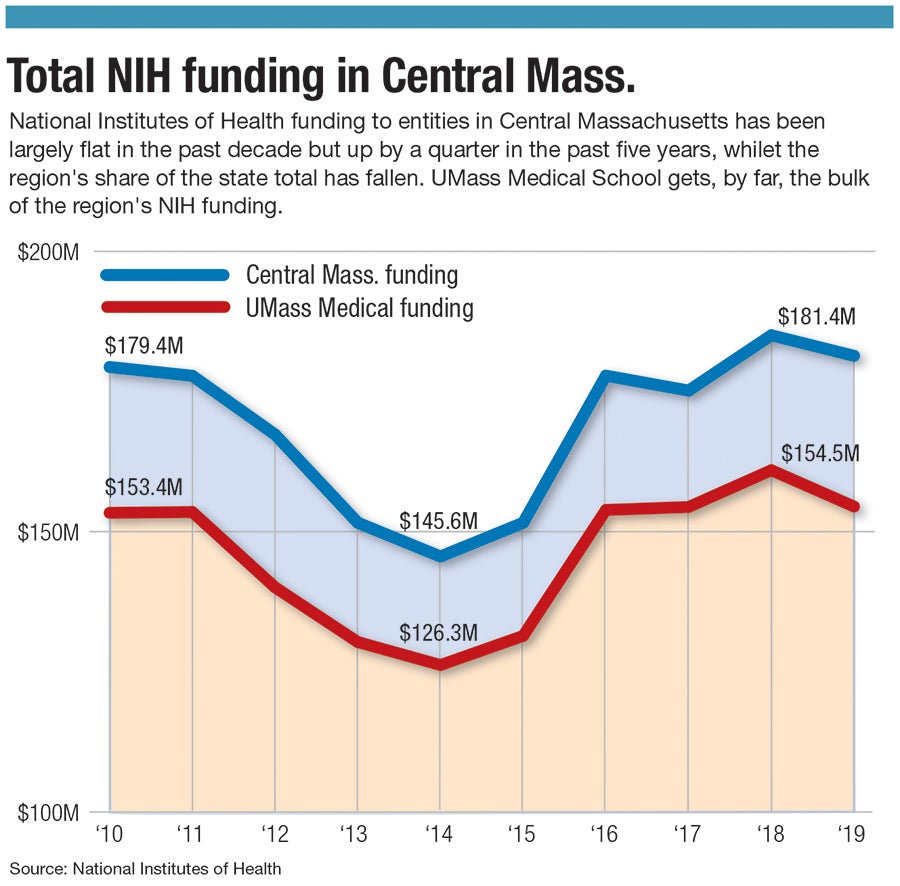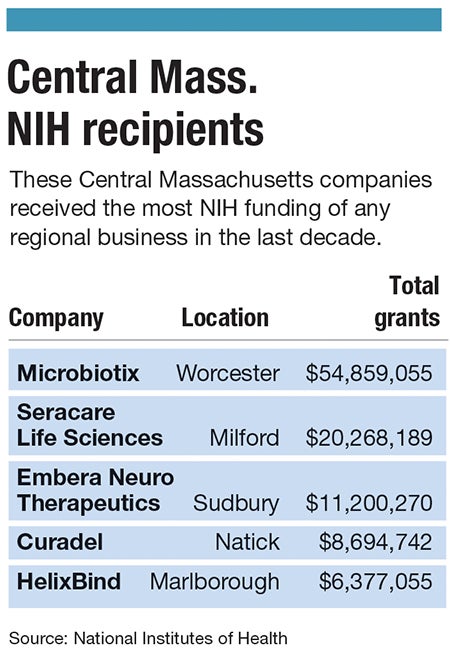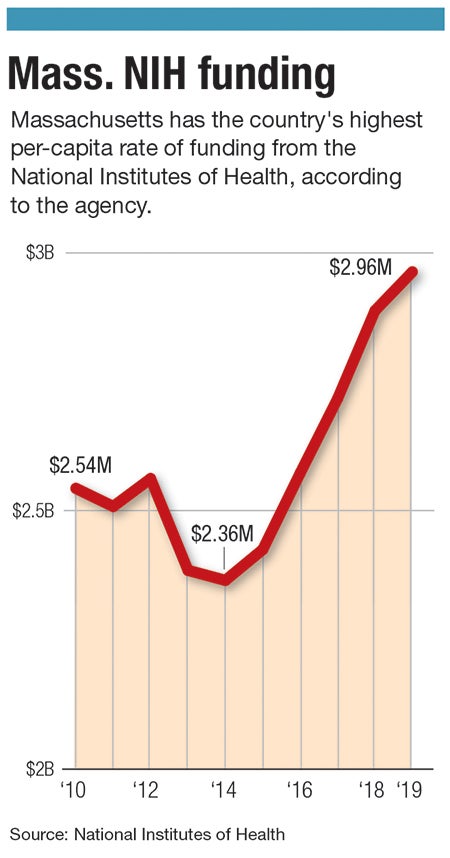Behind Central Massachusetts biotechnology research taking place to improve brain tumor procedures and genome editing techniques, or better treat addiction or pancreatic cancer, there’s one common element without which the work would be impossible.Those initiatives and hundreds of others in Central Massachusetts have relied on funds from the National Institutes of Health, money contributing the […]
Get Instant Access to This Article
Subscribe to Worcester Business Journal and get immediate access to all of our subscriber-only content and much more.
- Critical Central Massachusetts business news updated daily.
- Immediate access to all subscriber-only content on our website.
- Bi-weekly print or digital editions of our award-winning publication.
- Special bonus issues like the WBJ Book of Lists.
- Exclusive ticket prize draws for our in-person events.
Click here to purchase a paywall bypass link for this article.
Behind Central Massachusetts biotechnology research taking place to improve brain tumor procedures and genome editing techniques, or better treat addiction or pancreatic cancer, there’s one common element without which the work would be impossible.
Those initiatives and hundreds of others in Central Massachusetts have relied on funds from the National Institutes of Health, money contributing the bulk of work going to both major centers including UMass Medical School and Worcester Polytechnic Institute as well as small startups rising in their shadows.

“A lot of these ideas otherwise wouldn’t be able to necessarily advance,” said Jon Weaver, the president and CEO of Worcester biotech incubator Massachusetts Biomedical Initiatives (MBI), which works with several NIH funding recipients.
“It’s hard to underscore how important that is,” Weaver said.
An overwhelming majority of NIH funding coming to Central Massachusetts each year goes to UMass Medical School, which regularly earns the most funding in Massachusetts of any recipient outside Boston and Cambridge.
UMMS earns more funding than 20 entire states, according to NIH data, including more than the bottom six states – West Virginia, South Dakota, North Dakota, Alaska, Idaho and Wyoming – combined.
That funding, which totaled $154 million in fiscal 2019 and nearly $1.5 billion in the past decade, has contributed to some of the school’s most important research.
In the past year alone, researchers Guangping Gao and Erik Sontheimer at UMMS received funding to improve genome editing techniques. Christopher Sassetti’s research on the genetics of tuberculosis has been supported with NIH funding, as has Jeanne Lawrence for her work on Down syndrome.
In what could be the medical school’s most-known research, biologist Craig Mello received a Nobel Prize in 2006 for his work in regulating genes to potentially block diseases.
Mello is one of 158 NIH-supported researchers to become Nobel Laureates, according to NIH director Francis Collins, who visited the medical school in October and spoke at the annual meeting of the Worcester Regional Research Bureau.

Major funding at UMass and beyond
UMass doesn’t just draw research funding to its own campus: it’s attracted companies to set up across Plantation Street at the UMass Medicine Science Park, which have brought in millions in their own funding.
The largest business by NIH research funding in Central Massachusetts by far is Microbiotix, a clinical stage biopharmaceutical firm working to discover and develop drugs to target infectious diseases. Microbiotix has brought in nearly $55 million in NIH funding in the past decade.
A second biomedical hub has developed in Worcester at Gateway Park, which benefits from an affiliation with MBI and landlord WPI.
Gateway Park tenants Detectogen, Enrich, Nirogyone Therapeutics and ZATA Pharmaceuticals have all been NIH funding recipients, along with SignaBlok, a biopharmaceutical company developing a therapy for pancreatic cancer, among other focuses, including liver disease and sepsis.

SignaBlok has received more than $5 million in NIH funding, taking up the bulk of its revenue for drug development.
“There are not any effective treatments at all, and we feel we can make a difference,” said SignaBlok’s president and founder, Alexander Sigalov, a former UMass Medical School faculty member.
Worcester Polytechnic Institute has been a major recipient itself, with nearly $25 million in the past decade, including nearly half that amount in just the past three years.

WPI Professor Gregory Fischer has received $3.5 million over five years for a potential therapy for brain tumors using an MRI, or magnetic resonance imaging. Another professor, Haichong (Kai) Zhang, got $2 million to study imaging-based identification of aggressive prostate cancer.
Fischer’s work over the past decade aims to create extra-precise measurements for brain tumor operations. Today, he said, a measurement may be accurate at the time it’s taken but less so during an operation after pressure changes or patient reconfiguration. The difference can mean less of a tumor is removed, or that brain tissue is removed instead.
Fischer hopes the technology can be cleared for use in the next few years – something to benefit not only patients but also show a return on investment in the research funding.
“They really want to see these technologies brought to the market,” he said. “That’s how you can help patients.”
Getting attention
Among private firms bringing in the most research funding is Embera NeuroTherapeutics of Sudbury, which is working on an addiction treatment drug for which it has attracted $11 million in NIH funding.
Embera’s drug, which is in the second of a three-phase clinical trial, uses different methods of helping people kick addiction to cocaine and cigarette smoking, said Bob Linke, the company’s president and CEO. The treatment, which moderates activity in the stress response system, could hit the market in 2025 or 2026, he said.
“NIH funding has been instrumental,” said Linke. “We wouldn’t be doing these studies if not for NIH funding.”
Funding recipients in Central Massachusetts have also become acquisition targets.
Biomere, a Worcester biomedical pre-clinical testing firm, merged in May with a Chinese firm, JOINN Laboratories, making the Worcester office the company’s North American headquarters.
Seracare Life Sciences of Milford, a firm providing quality control materials for infectious disease testing with more than $20 million in NIH funding, was bought last fall by LGC, a British life sciences company.
IQuum, a Marlborough molecular diagnostics company attracting $5 million in NIH funding in the early years of this decade, was bought in 2014 by Roche, a Swiss healthcare company.
Benefits, quantifiable and not
Like in a lot of other economic areas – from property values to population growth to venture capital funding – Central Massachusetts is struggling to keep up with the rest of the state in NIH funding, with Massachusetts carried in large part by major research institutions in and around Boston.

Statewide, NIH funding is up 16.5% in the past decade – but just 1.1% in Central Massachusetts. The geographic center of the state accounted for 7.1% of NIH funding statewide a decade ago, but 6.1% in fiscal 2019.
Massachusetts has the highest per-capita NIH funding in the U.S., with nearly $2.9 billion in fiscal 2019 alone.
Collins, the NIH director, pitched the Worcester area’s outsized ability to attract funding as well as the vital role of research funding while visiting UMass Medical School and speaking at the Worcester Regional Research Bureau.
Collins, a geneticist who has led the NIH since 2009, touted the benefit of the funds for the work they make possible.
Statistics back that up, Collins said: Support for more than 433,000 jobs, and roughly $74 billion in new economic activity, for an estimated $8 return on investment for every $1 spent.
Then there’s the unquantifiable health benefits, he said. Cancer death rates, for example, are down 70% over the past six decades, and HIV therapies have helped patients live longer lives. Collins pointed to medical breakthroughs health experts foresee in the coming years, including targeted therapy for Alzheimer’s disease before symptoms even arrive, a universal flu vaccine to replace annual flu shots needed today, and use of neuroscience and structural biology to create new addiction prevention and pain treatment as a way to help solve epidemics such as opioid overdose deaths.
Collins said, and even at a time of vast disagreements among officials in Washington, support for health research funding has remained strong.
“There is bipartisan agreement in both houses,” he said, “that this is one of the things the government does that’s worthwhile.”

